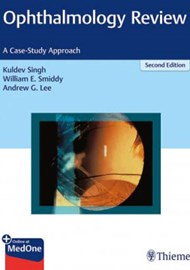Ophthalmology review is a ‘case-driven’ textbook which is aimed at medical students or trainees. It’s quite an inviting textbook – I picked it up and flicked through and felt like this is something I would actually like to read. It has a clear layout, plenty of pictures, and covers quite a large variety of basic topics.
The book has 11 parts which cover:
- Cornea and external disease
- Lens
- Glaucoma
- Retina
- Uveitis
- Tumours
- Posterior segment complications
- Trauma
- Neuro-ophthalmology
- Paediatrics
- Orbit / Oculoplastic
Within each section various conditions are covered. For each condition you get around three to four pages, which start with an abstract, followed by a history, differential diagnosis, test interpretation, diagnosis, medical management, surgical management and rehabilitation and follow-up. It then ends with a suggested reading list if you want to delve further into that condition. The neuro-ophthalmology and orbit sections are particularly comprehensive and there are some nifty pages covering conditions that can be glossed over in other textbooks such as how to handle retained lens material after cataract extraction.
The last edition was published in 2002 and this new edition contains some much needed updates due to the significant advances in ophthalmology, e.g. the now routine use of anti-VEGF.
The format will appeal to you if you find it easier to remember things when it’s put into the context of a case. What’s really nice is when it mentions a sign in the example case it usually has a figure showing you what it looks like, helping you to picture what is being described. As someone who often has to keep google open alongside a textbook to look for images, this was much appreciated.
This textbook delivers exactly what it promises to do in the preface; it’s a basic textbook which quickly guides you through some of the more common conditions. It’s unlikely to be of use to the more senior healthcare professional, but it doesn’t pretend to be aimed at this particular subgroup. I would probably echo the sentiments of a review from the American Journal of Ophthalmology which looked at the first edition; it’s such a great textbook for beginners, but it would be nice if it incorporated a few other conditions that a junior may encounter, e.g. anterior uveitis. However, all in all I would definitely recommend it if you’re new to ophthalmology and need a nice easy to read book to get to grips with some of the essentials.




